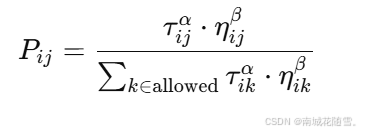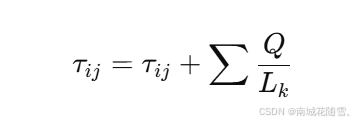蚁群算法(Ant Colony Optimization, ACO)是一种基于自然界中蚂蚁觅食行为的优化算法,主要用于解决组合优化问题,特别是旅行商问题(TSP)等路径优化问题。算法通过模拟蚂蚁释放和跟随信息素(Pheromone)的行为,实现多个解的迭代优化,具有强大的全局搜索能力。
1. 算法思想
在自然界中,蚂蚁通过释放信息素来标记行走的路径,其他蚂蚁倾向于选择信息素浓度更高的路径。随着时间的推移,信息素浓度高的路径会吸引更多的蚂蚁,使得蚂蚁逐渐趋向于较短的路径。蚁群算法模拟这种信息素机制,用于寻优问题。
2. 核心概念
-
蚂蚁(Ant):在算法中,每只蚂蚁代表一个解。算法会在每轮迭代中派遣多个蚂蚁寻找路径,每只蚂蚁基于信息素和启发函数选择下一步。
-
信息素(Pheromone):每条路径上会有一定浓度的信息素,表示蚂蚁对路径的偏好。路径上信息素越多,蚂蚁选择该路径的概率越大。
-
启发式信息(Heuristic Information):为加强局部选择性,算法中通常引入距离、成本等启发信息,帮助蚂蚁判断路径的吸引力。
-
信息素更新(Pheromone Update):每轮迭代结束后,算法会根据路径质量更新信息素,优秀路径的信息素增加,较差路径的信息素则因挥发而减少。
3. 蚁群算法的步骤
初始化
- 初始化参数:设定信息素浓度、蚂蚁数量、信息素挥发系数等参数。
- 初始化信息素矩阵:通常初始化所有路径的初始信息素浓度为相同值。
迭代过程
每一轮迭代中,算法执行以下步骤:
-
路径选择:每只蚂蚁从一个起点开始,根据信息素浓度和启发式信息选择下一节点,构建完整的解。
- 路径选择的概率计算公式通常为:

-
- 其中:
- τij 表示路径 i 到 j 的信息素浓度;
- ηij 是启发式信息(如距离的倒数);
- α 和 β 是调整信息素和启发式信息重要性的参数。
- 其中:
-
路径评估:所有蚂蚁构建完解后,评估每条路径的质量(如路径总长度、路径花费等)。
-
信息素更新:
- 信息素挥发:对所有路径信息素进行衰减,防止信息素无限增加导致过早收敛。

- 其中,ρ 是信息素挥发率。
- 信息素增加:对本轮迭代中的优秀路径增加信息素,通常使用每条路径的总花费倒数表示贡献

-
- 其中 L 是路径的长度,Q 是信息素增强常数。
- 迭代:重复上述过程,直到满足终止条件(如达到最大迭代次数或找到满足条件的解)。
4. 参数设置
- 信息素重要性参数 α:影响蚂蚁对信息素的依赖程度。值越大,蚂蚁对信息素的依赖越强。
- 启发信息重要性参数 β:影响蚂蚁对启发信息(如距离)的依赖程度。值越大,蚂蚁更倾向于选择近距离的节点。
- 信息素挥发系数 ρ:控制信息素的衰减速率,值越小保留的信息素越多,影响路径的多样性。
- 信息素增强常数 Q:决定信息素增加量,通常根据问题的规模和路径的质量设置。
5. Java 实现示例(旅行商问题)
以下代码示例展示了蚁群算法解决旅行商问题的核心逻辑:
java
import java.util.Random;
public class AntColonyTSP {
private static final int CITIES = 5;
private static final int ANTS = 10;
private static final int MAX_ITERATIONS = 1000;
private static final double ALPHA = 1.0; // 信息素重要性
private static final double BETA = 5.0; // 启发信息重要性
private static final double EVAPORATION = 0.5; // 信息素挥发率
private static final double Q = 100; // 信息素增强常数
private double[][] distances;
private double[][] pheromones;
private Random random = new Random();
public AntColonyTSP(double[][] distances) {
this.distances = distances;
this.pheromones = new double[CITIES][CITIES];
// 初始化信息素矩阵
for (int i = 0; i < CITIES; i++) {
for (int j = 0; j < CITIES; j++) {
pheromones[i][j] = 1.0;
}
}
}
public void solve() {
int[] bestTour = null;
double bestTourLength = Double.MAX_VALUE;
for (int iteration = 0; iteration < MAX_ITERATIONS; iteration++) {
int[][] tours = new int[ANTS][CITIES];
double[] tourLengths = new double[ANTS];
// 每只蚂蚁生成一条路径
for (int ant = 0; ant < ANTS; ant++) {
tours[ant] = constructTour();
tourLengths[ant] = calculateTourLength(tours[ant]);
// 更新最佳路径
if (tourLengths[ant] < bestTourLength) {
bestTourLength = tourLengths[ant];
bestTour = tours[ant];
}
}
// 更新信息素
evaporatePheromones();
for (int ant = 0; ant < ANTS; ant++) {
depositPheromones(tours[ant], tourLengths[ant]);
}
}
// 输出最优解
System.out.println("Best tour length: " + bestTourLength);
System.out.print("Best tour: ");
for (int city : bestTour) {
System.out.print(city + " ");
}
System.out.println();
}
private int[] constructTour() {
boolean[] visited = new boolean[CITIES];
int[] tour = new int[CITIES];
int currentCity = random.nextInt(CITIES);
tour[0] = currentCity;
visited[currentCity] = true;
for (int i = 1; i < CITIES; i++) {
int nextCity = selectNextCity(currentCity, visited);
tour[i] = nextCity;
visited[nextCity] = true;
currentCity = nextCity;
}
return tour;
}
private int selectNextCity(int currentCity, boolean[] visited) {
double[] probabilities = new double[CITIES];
double sum = 0.0;
for (int city = 0; city < CITIES; city++) {
if (!visited[city]) {
probabilities[city] = Math.pow(pheromones[currentCity][city], ALPHA) *
Math.pow(1.0 / distances[currentCity][city], BETA);
sum += probabilities[city];
} else {
probabilities[city] = 0.0;
}
}
double rand = random.nextDouble() * sum;
for (int city = 0; city < CITIES; city++) {
if (!visited[city]) {
rand -= probabilities[city];
if (rand <= 0.0) {
return city;
}
}
}
return -1;
}
private double calculateTourLength(int[] tour) {
double length = 0.0;
for (int i = 0; i < CITIES - 1; i++) {
length += distances[tour[i]][tour[i + 1]];
}
length += distances[tour[CITIES - 1]][tour[0]];
return length;
}
private void evaporatePheromones() {
for (int i = 0; i < CITIES; i++) {
for (int j = 0; j < CITIES; j++) {
pheromones[i][j] *= (1 - EVAPORATION);
}
}
}
private void depositPheromones(int[] tour, double tourLength) {
double pheromoneToDeposit = Q / tourLength;
for (int i = 0; i < CITIES - 1; i++) {
pheromones[tour[i]][tour[i + 1]] += pheromoneToDeposit;
pheromones[tour[i + 1]][tour[i]] += pheromoneToDeposit;
}
pheromones[tour[CITIES - 1]][tour[0]] += pheromoneToDeposit;
pheromones[tour[0]][tour[CITIES - 1]] += pheromoneToDeposit;
}
public static void main(String[] args) {
double[][] distances = {
{0, 2, 2, 5, 7},
{2, 0, 4, 8, 2},
{2, 4, 0, 1, 3},
{5, 8, 1, 0, 2},
{7, 2, 3, 2, 0}
};
AntColonyTSP tsp = new AntColonyTSP(distances);
tsp.solve();
}
}6. 蚁群算法的优缺点
优点
- 全局搜索能力强:通过信息素累积和随机选择,使得蚁群算法具有较强的全局搜索能力。
- 动态适应性:路径上的信息素会逐渐调整,使算法在搜索过程中动态适应局部环境。
缺点
- 参数敏感:信息素衰减率、信息素和启发信息权重等参数选择对算法效果影响大。
- 收敛速度:可能收敛较慢,尤其在早期迭代中探索较多,适用于解决规模适中的问题。
7. 应用
蚁群算法适用于多种组合优化问题,尤其是在路径规划、调度、网络路由等方面。